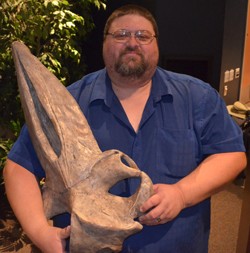How bone fragments led to paleontological model highlights Museum of the Earth Sciences lecture

Butch Dooley, paleontology curator of the Virginia Museum of Natural History, with the model of the upper jaw of Buttercup, a baby whale of the extinct species Diorocetus hiatus, that he and the museum staff fashioned after studying fossil fragments.
Scientific interpretation of the story told by just a few bone fragments was the subject of the March Museum of the Earth Sciences Lecture by Butch Dooley, paleontology curator of the Virginia Museum of Natural History (VMNH), on Tuesday, March 4, in the Hurlburt Auditorium.
Titled "Reconstructing Buttercup . . . From Scraps of Bones to a Fossil Whale," Dooley's talk was followed by questions and answers from more than 40 faculty, staff, students and guests.
Dooley detailed the challenges faced by the museum staff as it attempted to recreate the upper jaw of Buttercup, believed to be a baby whale of the extinct species Diorocetus hiatus. An "exciting find" of six pieces of an ear and cheek bone led to Dooley's narrative of how the researchers recreated the whale's upper jaw. Models of the fossils were made and then assembled to become the key piece around which a model could be assembled.
Buttercup was discovered in Carmel Church Quarry in Caroline County, Virginia, just north of Richmond in 2011 along with thousands of Miocene-age fossils, ranging from whales to sharks, fish, turtles, crocodiles, seals and sea cows.
"The big charismatic things there are the whales, there are over two dozen we have found," he said.
Buttercup is of particular interest, he said, because young specimens are rare. Dooley offered an overview of the scientific process of research, deduction and hypothesis by which paleontologists determined key measurements that led to the recreation of Buttercup's upper jaw, which was on display.
"We combed the literature until we found Russian and Japanese scientific literature from the '50s about modern whales, Buttercup's successors, that gave us some proportions with which to work," he said and added that fully-restored adults of the same species from the same site and in Maryland provided additional clues and guidance to what a pre-adolescent Diorecetus hiatus would look like.
As a next step, Dooley talked of how a small fragment might lead to the VMNH's development of a lower jaw model for Buttercup as well and the process by which the museum is investigating the opportunity.
The final Spring 2014 Museum of the Earth Sciences Lecture will be on Tuesday, April 1, at 7 p.m. in the Hurlburt Auditorium by Parvinder Sethi, professor of geology at RU. The museum is part of the Department of Geology in the College of Science and Technology and an affiliate of the Virginia Museum of Natural History. The Museum serves as an educational resource for earth science-related themes for the university, K-12 communities and the general public. It is open from October through November and from January through April while RU is in session.
To learn more about the Museum of the Earth Sciences or the lecture series, contact Steve Lenhart at (540) 831-5257 or slenhart@radford.edu.